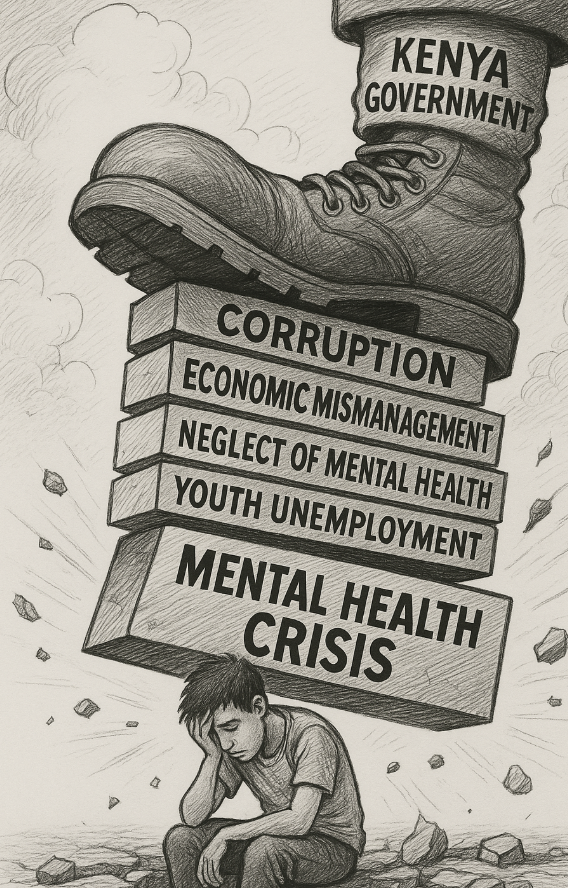
NAKURU
Kenya is facing a silent national emergency—an escalating mental health crisis driven not by biology alone, but by the cumulative failures of political leadership and economic mismanagement. With nearly 1.9 million Kenyans battling depression, the country ranks fourth in Africa for reported cases, according to a 2021 study, and fifth according to the 2017 WHO report. Depression, anxiety, and other mental disorders affect one in four Kenyans over their lifetime, with young people aged 13–34 and older adults aged 55–74 bearing the highest burden.
But this is not merely a health sector problem—it is a political and economic one. Systemic corruption, crippling debt, policy failure, and chronic underinvestment in mental health services are combining to create fertile ground for despair. The Gen Z-led protests of 2023–2025 are not just about taxes or fees—they are the cries of a generation pushed to the edge.
1. Corruption and Inequality: A Broken System
At the heart of Kenya’s mental health crisis is deep-rooted, systemic corruption. Despite achieving a GDP of $121 billion in 2024—the largest in Eastern and Central Africa—one in four Kenyans lives in poverty. This paradox reflects a government that enables elite accumulation of wealth while neglecting the basic needs of the majority.
Data from the Kenya National Bureau of Statistics reveals a disturbing reality: 0.1% of Kenyans control more wealth than 99% of the population. Corruption skews public spending, disrupts market competition, and robs ordinary citizens of economic opportunity. The BTI 2024 Kenya Country Report underscores the government’s superficial anti-corruption efforts, noting that political elites routinely evade accountability.
The impact on mental health is direct and devastating. Misallocated resources mean fewer mental health professionals, poorly equipped facilities, and no national safety net for those silently suffering. Despair becomes institutionalized.
2. Economic Mismanagement: When Growth Betrays the People
Kenya’s economic policies have failed to deliver inclusive growth. A debt-to-GDP ratio surpassing 70% means nearly a third of government revenue is spent servicing debt—leaving crumbs for healthcare, education, and mental health. Inflation hit 7.7% in 2023, and regressive tax hikes from the 2023 and 2024 Finance Bills have driven up the cost of food, fuel, and school fees.
University tuition has tripled—from KSh 38,000 to KSh 122,000—closing doors to thousands of bright young Kenyans. Meanwhile, youth unemployment remains stubbornly high. With 34% of Kenyans expected to live below $2.15/day by 2025, it’s no surprise that mental health conditions are rising.
The World Bank confirms that poverty reduction has stalled. In the absence of hope, stress, anxiety, and depression become the new normal—especially for Gen Z and rural youth facing a bleak future.
3. Political Neglect of Mental Health Infrastructure
Kenya’s mental health system is chronically underfunded and politically neglected. Despite the Kenya Mental Health Policy 2015–2030 outlining ambitious reforms, implementation remains minimal. The country has only 88 psychiatrists for over 50 million citizens, and only 16 counties have any public psychiatrist at all.
In contrast, billions are funneled into flashy infrastructure projects. According to the World Bank, 8.59% of funding goes to transport, and 8.06% to energy, while health receives only 5.79%. Meanwhile, Mathari Hospital, Kenya’s largest mental health facility, remains outdated and overwhelmed.
Adding insult to injury, Section 226 of the Penal Code still criminalizes attempted suicide—a cruel colonial relic that deters people from seeking help. This is not just negligence. It is institutionalized indifference.
4. The Crisis of Youth: Unemployment, Pressure, and Lost Hope
Kenya’s youth are not just unemployed—they are disillusioned. According to KNBS, nearly 39% of youth are jobless, and 9 in 10 unemployed Kenyans are under 35. Vision 2030 promised jobs and opportunity, but what many youths have received are token handouts: motorbikes, posho mills, and “youth funds” that lack long-term vision.
Meanwhile, gender-based violence affects 45% of Kenyan women, and rising social expectations—academic success, financial independence, marriage—further pressure young people. Yet, the government has failed to build community-based mental health support systems or safe spaces for the vulnerable.
The result? A generation in crisis—angry, exhausted, and unheard.
5. Climate Shocks and Pandemic Fallout: The Missing Safety Net
The impact of climate change and COVID-19 has made everything worse. Between 2022 and 2024, droughts and floods displaced over 6.7 million people, while the pandemic pushed 2 million more into poverty. School closures worsened adolescent mental health, and dropout rates surged—especially in arid regions like Turkana and Garissa.
Yet the Kenyan government failed to integrate mental health into disaster response frameworks, despite World Bank recommendations. There were no widespread psychosocial support programs, no increased funding for rural mental health services, and no resilience-building policies. For millions, trauma is left untreated.
Conclusion: Political Apathy Breeds Psychological Collapse
Kenya’s mental health crisis is a reflection of state failure. From unchecked corruption and policy missteps to the collapse of mental health infrastructure and youth neglect, the government’s indifference has left millions adrift.
To reverse course, Kenya must:
- Decriminalize attempted suicide and reform colonial mental health laws
- Invest meaningfully in mental health infrastructure and professionals
- Create employment pathways for youth, beyond token schemes
- Redirect funds from vanity projects to healthcare and social protection
- Integrate mental health into climate, pandemic, and disaster planning
- Tackle gender-based violence and social inequalities at the root
Until these steps are taken, Kenya’s most valuable resource—its people—will continue to break under the weight of a system that refuses to care.
Sources:
- World Health Organization (2017)
- Kenya National Bureau of Statistics
- Kenya Mental Health Policy 2015–2030
- World Bank Kenya Economic Update (2024)
- BTI 2024 Kenya Country Report
- Human Rights Watch World Report 2025
- The Lancet (2023), Global Burden of Disease
- Kenya National Commission on Human Rights
- Posts on X (formerly Twitter) reflecting public sentiment
